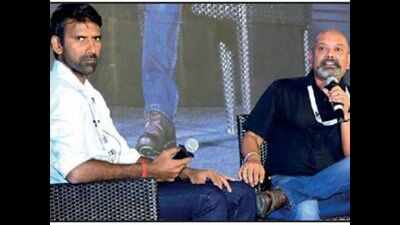- News
- City News
- bengaluru News
- Players must be honest about injuries: Lakshmipathy Balaji
Trending
This story is from January 20, 2020
Players must be honest about injuries: Lakshmipathy Balaji
Pressure, fear of failure and injuries are the worst nightmares for any sportsperson. Preventing injuries is comparatively a new concept in Indian sports but the interest and awareness are growing, felt experts and eminent sportspersons at a global sports injury conclave here on Saturday.

Lakshmipathy Balaji (left) and Ramji Srinivasan
Former Indian speedster Lakshmipathy Balaji said players must be honest about injuries.

Sharing his experience of dealing with a stress fracture, which ruled him out of the game just three years after he made his international debut, Balaji said players should not rely entirely on the opinions of support staff or others’ while dealing with an injury. Instead, the responsibility should be theirs. “I started playing cricket with the leather ball at the age of 17 and within five years I got into the national side. The process of elevation was so fast that there was no time to tackle or awareness about injuries. The training was not part of the system or was in its infancy and the concept of strength and conditioning did not exist. The current generation has the knowledge of how important fitness is and the steps to be taken to prevent injuries,” he said. “One needs to know about one’s body, types of injury and training methods. Before undergoing surgery for my back injury, I did proper research on it, I contacted players like Shane Bond who had undergone similar surgeries, sent my medical reports to doctors across the globe.”
Former strength and conditioning coach of Team India Ramji Srinivasan touched upon the importance of having elaborate data on injuries which can complement the Indian scenario well. “Awareness and access to research materials have progressed well in the last 10 years. But we need data pertaining to India and Indians when it comes to sports injuries. We cannot borrow the data bank of other countries just like that,” he said.
Referring to the recent injury management blooper with an Indian pacer, he said: “Borrowing foreign case studies and skills and methods of workouts may look easier but for long-term athletic development we need our own set of information. Case studies like why Indian pacers predominantly get a particular injury, medical screening results etc will help support staff to better deal the issue.”
Dr Ali Irani, Indian cricket team’s first physiotherapist pointed to the positive developments in sports injury management. “We are now engaged in research involving brain mapping to deal with injury prevention. I see a bright future as far as injury prevention is concerned,” he said.
End of Article
FOLLOW US ON SOCIAL MEDIA






